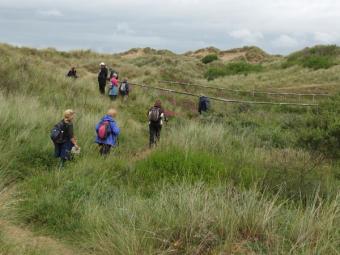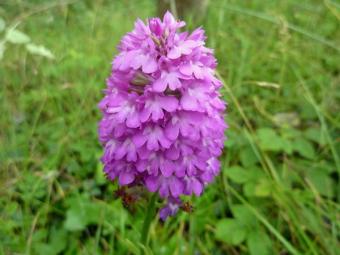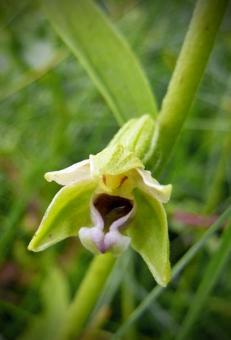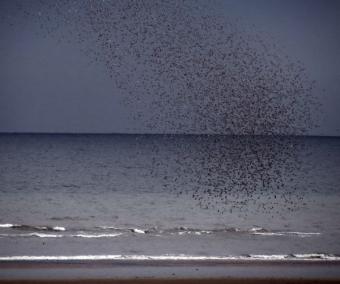 Exploring The Sand DunesA full minibus plus Annie came on this week's trip to Birkdale Green Beach. On arrival we were met by Pat Lockwood and Dr Phil Smith. We were very grateful that they had given their time to lead this walk. Their enthusiasm and expertise proved invaluable in gleaning the most from this very unique habitat. Before we ventured onto the dunes we looked at a piece of land near the beach, where we saw large flowered evening primrose, blue fleabane and knotted pearlwort.
Exploring The Sand DunesA full minibus plus Annie came on this week's trip to Birkdale Green Beach. On arrival we were met by Pat Lockwood and Dr Phil Smith. We were very grateful that they had given their time to lead this walk. Their enthusiasm and expertise proved invaluable in gleaning the most from this very unique habitat. Before we ventured onto the dunes we looked at a piece of land near the beach, where we saw large flowered evening primrose, blue fleabane and knotted pearlwort. Pyramidal Orchid Meadow pipits were flitting in and out of the sea buckthorn, a plant which is becoming quite invasive and would dominate the landscape here if not kept in check. We then headed for the sand dunes - a beautiful specimen of pyramidal orchid was seen and Maddy spotted a rat run through the vegetation. We saw many unusual plants, some of which are nationally scarce and plants that we have previously seen in small numbers grew in profusion here. Especially notable was the abundance of grass of parnassus, round leaved wintergreen and marsh helleborine. This years unseasonally wet weather has made this habitat much wetter than usual and wellies would have made walking around a little easier.
Pyramidal Orchid Meadow pipits were flitting in and out of the sea buckthorn, a plant which is becoming quite invasive and would dominate the landscape here if not kept in check. We then headed for the sand dunes - a beautiful specimen of pyramidal orchid was seen and Maddy spotted a rat run through the vegetation. We saw many unusual plants, some of which are nationally scarce and plants that we have previously seen in small numbers grew in profusion here. Especially notable was the abundance of grass of parnassus, round leaved wintergreen and marsh helleborine. This years unseasonally wet weather has made this habitat much wetter than usual and wellies would have made walking around a little easier.  Dune HelleborineWe had lunch on the sand dunes and in the afternoon we moved onto the green beach. Unfortunately we did not see natterjack toads but we did see 3 good sized common frogs and a short winged conehead which is associated with the sea club rush that grows here. Linnets were seen on the alder and a large flock of knot formed a veritable cloud as they flew in. Sandwich terns were also spotted. These were among only 18 birds recorded today. The weather had been good to us for most of the day but was now changing. 154 plants were recorded, 136 of them in flower. Orchids seen - pyramidal, early marsh (incarnata and coccinea), southern marsh, pyramidal, dune helleborine and marsh helleborine. Other plants of note include slender spikerush, tubular water dropwort, seaside centaury (seen growing alongside common centaury),
Dune HelleborineWe had lunch on the sand dunes and in the afternoon we moved onto the green beach. Unfortunately we did not see natterjack toads but we did see 3 good sized common frogs and a short winged conehead which is associated with the sea club rush that grows here. Linnets were seen on the alder and a large flock of knot formed a veritable cloud as they flew in. Sandwich terns were also spotted. These were among only 18 birds recorded today. The weather had been good to us for most of the day but was now changing. 154 plants were recorded, 136 of them in flower. Orchids seen - pyramidal, early marsh (incarnata and coccinea), southern marsh, pyramidal, dune helleborine and marsh helleborine. Other plants of note include slender spikerush, tubular water dropwort, seaside centaury (seen growing alongside common centaury),  Flock of Knotsea rocket, strawberry clover, rough clover and lesser water plantain. 5 species of butterfly were recorded - meadow brown, common blue, gatekeeper, small skipper and ringlet. Several moths were seen including yellow shell and small blood vein. With the rain getting heavier we headed back to the bus along the beach but it did not spoil the day. This is a botanist's paradise and John said this had been his most favourite BEES trip ever. Many thanks to Joan for organising the day.
Flock of Knotsea rocket, strawberry clover, rough clover and lesser water plantain. 5 species of butterfly were recorded - meadow brown, common blue, gatekeeper, small skipper and ringlet. Several moths were seen including yellow shell and small blood vein. With the rain getting heavier we headed back to the bus along the beach but it did not spoil the day. This is a botanist's paradise and John said this had been his most favourite BEES trip ever. Many thanks to Joan for organising the day.Sue
